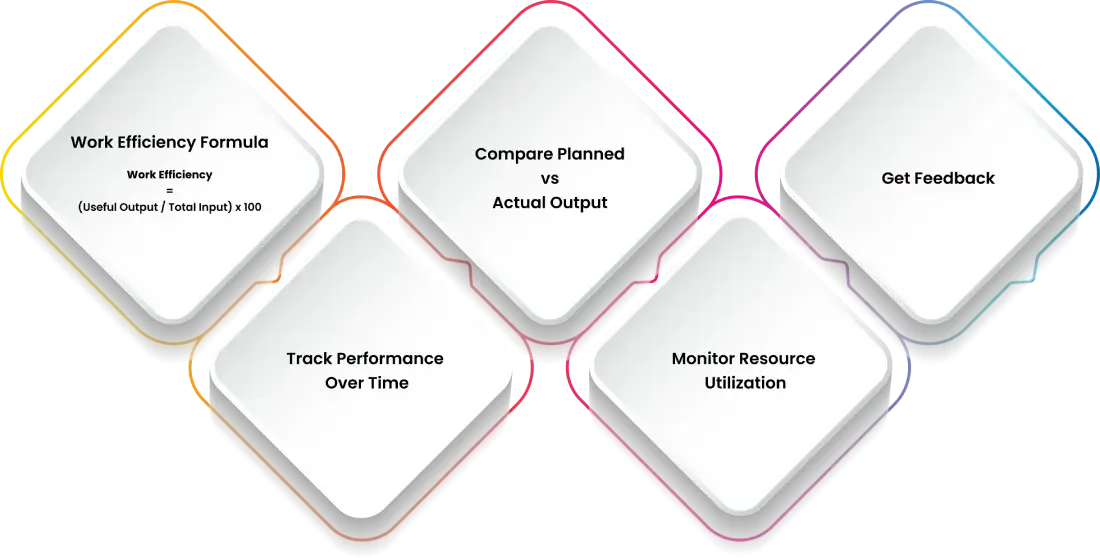In the current competitive labor market, achieving work efficiency at all levels is essential for individuals and organizations alike. Completing a task faster, smarter, and with fewer resources is not only timesaving, but it also increases overall productivity and success booster. For many professionals, knowing what work efficiency is and how to improve it can provide them with an opportunity to attain and sustain an advantage (especially in fast-moving or high-pressure industries).
This blog will cover a definition of work efficiency, its importance, examples in practice, and actionable ways to improve efficiency. Whether you're working from home or in an office, improving your work efficiency means achieving improved results on work tasks with less effort. We will also help you with a simple way of calculating efficiency so you can track your progress and evidence-based changes.
Work efficiency can be defined as the completion of tasks using the least amount of time and resources in a way that quality is maintained. In other words, it coordinates the inputs (e.g., time, effort) with the outputs to create value.
Efficient employees do not just work harder to be efficient; they work smarter. The objective of improving work efficiency is to reduce waste by improving the workflow and therefore enhance the output with the same level of quality, if not higher output and quality. Good work efficiency can help meet a deadline without burning out, and consistent deadline meeting can influence work efficiency.
Work efficiency is not just about speed, but how a task is sequenced and executed. Work efficiency is about removing unnecessary elements and focusing and the optimal use of tools or resources that are already available. This issue is particularly important for industries and roles where time equates to money, for instance, consulting, software engineers (coders), delivery, and customer service.
On a wider scale, work efficiency is about ensuring that groups, teams, and departments are working together towards agreed-upon goals and objectives. If each worker strives to optimise their workflow, the organisation is more productive. Work efficiency leads to higher job satisfaction, less stress, work-life balance, and a more productive work pace.
Efficiency at work matters because efficiency relates closely to productivity and cost-effectiveness, and employee satisfaction. Employers want a team that is highly efficient so they can get more work done with the least amount of errors. Efficient performance will help everyone to reach personal goals in business and increase productivity. For employees, personal productivity improves when the workday is finished and there is still an energy bank for personal time.
Less stress and burnout contribute to enhanced efficiency. Tasks can be done in a way that does not lead to weekend crunches or late-night efforts. In all business environments, such as remote, hybrid, or office, high workplace efficiency enables companies to compete against other companies to become strategy-delivery machines ahead of competitors without the stress to maintain that level of performance. Efficiency at work is a fundamental requirement for organizational success.
1. Task Prioritization: An employee prioritizes their tasks using the Eisenhower Matrix, which means completing the most urgent and important tasks first. The employee completes more tasks in less time, and the deadlines are not missed because less time is wasted on less important tasks.
2. Automating Repetitive Tasks: A marketing team uses scheduling tools to automate social media posts and notifications. This saves each team member several hours a week on social media posts and ensures that a social media presence is maintained.
3. Time Blocking: An employee working remotely utilizes time blocking to reserve time blocks for focused work and to work on specific projects without distractions. This helped the employee significantly increase their concentration and build better momentum while working on specific tasks.
4. Using Templates: Content writers use standardized templates for reports and articles to minimize the time spent formatting and to ensure consistency.
5. Delegating Wisely: A team leader selected and assigned tasks based on team members' strengths. As a result, the project was completed faster with fewer revisions.

Clear, achievable goals provide direction and help strategic planning and prioritization. It may help to define goals as SMART goals (Specific, Measurable, Achievable, Relevant, and Time-bound).
Disable notifications that aren't time-sensitive and design your space to minimize distractions. This will help you maintain focus and be more productive.
Take advantage of task management applications, time-tracking applications, and communication applications to make things more fluid and avoid miscommunication.
You can break down big projects or full workloads into smaller pieces. This allows you to develop manageable work and prevents feeling overwhelmed. Additionally, completing the pieces will give you a feeling of accomplishment.
Time management generally applies time management ideas like the Pomodoro method or time blocking to focus on work during work sessions. .
Share the workload, ideas, and don't be afraid to share ideas and concepts. When a team can collaborate effectively, it can complete the work faster and at a higher level of quality.
Short breaks help to reset your focus. Studies show that taking regular breaks will have a positive effect on long-term productivity.
Provide clear communication and make it timely, so misunderstandings are prevented, and you cut down on revision time or mistakes.

Work Efficiency Formula
The most common formula to measure work efficiency is:
Work Efficiency = (Useful Output / Total Input) x 100
For example, if a worker completes tasks worth 8 hours of output in 10 hours of work:
Efficiency = (8 / 10) x 100 = 80%
Track Performance Over Time
Use productivity tools and project tracking systems to measure how much work is completed within set timeframes.
Compare Planned vs Actual Output
Review the original task plan against what was accomplished to assess areas of improvement.
Monitor Resource Utilization
Check how well tools, time, and workforce are being utilized. Overuse or underuse indicates inefficiencies.
Get Feedback
Managers and colleagues can offer insights into efficiency gaps and suggest improvements.